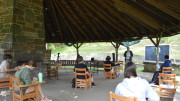The 2016 Presidential Election is less than a year away and the Grand Old Party (GOP) and Democratic debates are getting Americans familiar with each candidate. There has been a shift in culture in terms of how people are following the election and the use of other sources to monitor it.
In this digital age, social media is more influential than in the past and is taking over previously traditional news outlets as the main platform people are using to keep up with the elections. Politicians are changing their approach to advertisements and other ways of reaching out to individuals using social media platforms.
According to the Pew Research Center, 16 percent of registered voters followed a candidate on social media following the 2014 midterm elections, which is a 10 percent rise from 2010.
Popular presidential candidates Hillary Clinton (Democrat), and Donald Trump (Republican) are prominent social media users. Each respective candidate has over four million Twitter followers to 15-second clips on Instagram. Clinton has used Snapchat on various occasions to reach out to the younger audience.
Bernie Sanders (Democrat) has been using his own hashtag, #FeeltheBern, on Twitter, and Jeb Bush (Republican) used Snapchat to announce his bid for presidency.
Social media is popular with young adults. Millennials are shifting to live-streaming video and specific apps such as Snapchat, Instagram, Facebook, and Twitter to get the latest news on news surrounding the election.
With the shift in culture among millennials in relation to social media and the elections, this also applies to current McDaniel students.
Out of ten Political Science students at McDaniel, eight said they use social media to keep up with the elections rather than television. All eight of those students also said they follow politicians on either Twitter, Facebook or Instagram. The politicians ranged from 2016 Presidential candidates such as Hillary Clinton, Bernie Sanders, Ben Carson and Jeb Bush to their respective local representatives.
“Young adults and college students have the ability to connect with primary source information that represents the viewpoints of the different candidates, rather than being forced to obtain their information via secondary source mediums such as television or internet news websites,” said McDaniel political science professor Francis Grice.
“A pithy comment on Twitter or Facebook to a large audience could do wonders for a candidate’s campaign, but a poorly chosen remark could also lead rapidly to ruin,” he added.
The growth in power of social media as a prominent source of news and information, and it will be interesting to see how campaigns continue to strategize around this new way of reaching voters. Traditional ways of reaching voters seem to be diminishing, and we have yet to see what effect this will have on the election in 2016.




